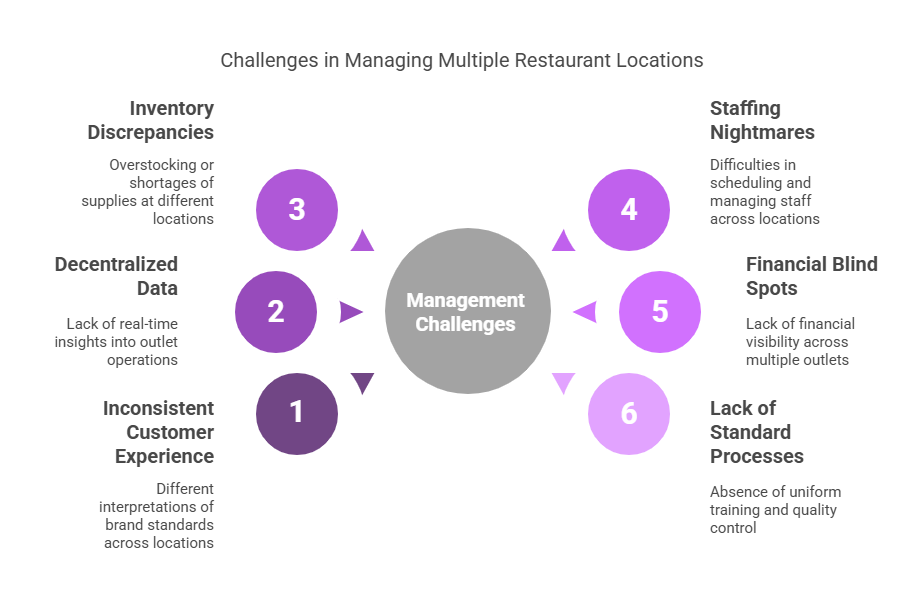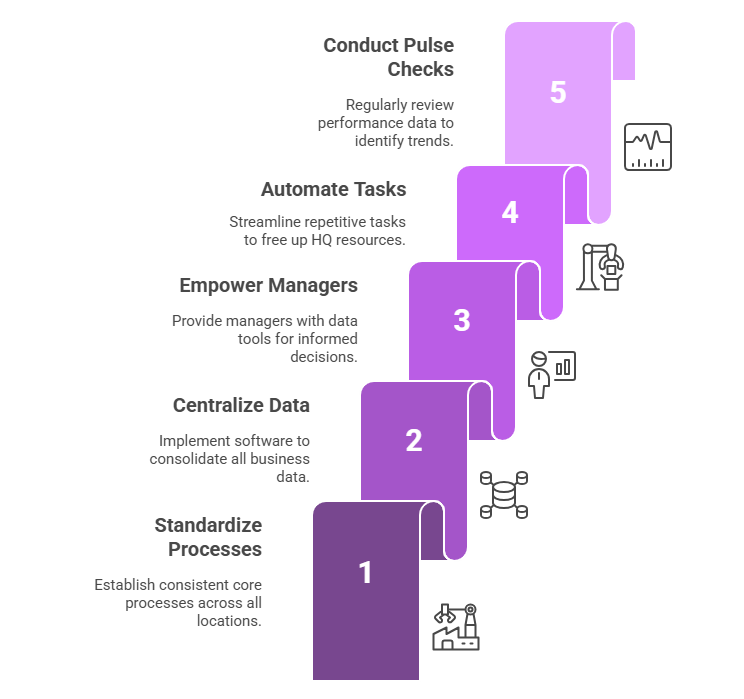For years, we watched it happen again and again.
A local restaurant takes off. The menu is solid. The staff? Like family. Customers love it. Profits are strong. Then comes the dream: “Let’s open another one.”
Next thing you know, they’re juggling two, three, maybe five restaurant locations. And suddenly, what was once a smooth operation turns into a game of restaurant whack-a-mole.
Inventory goes missing. Scheduling becomes chaotic. Quality starts slipping. Customers at the new location aren’t getting the same experience. You’re constantly asking: “Why can’t they just do what we do at the first one?”
If that sounds familiar, you’re not alone. Multi-unit restaurant management comes with a different playbook. It’s not just about serving good food anymore. It’s about systems. And today, it’s about smart software and operational clarity.
Let’s break it all down—what goes wrong, what needs to change, and how the right tools can give you back control.
What is Multi-Unit Restaurant Management?
Multi-unit restaurant management refers to the coordination and oversight of operations across multiple restaurant locations under the same brand. This includes managing staff, supply chain, inventory, menus, promotions, finances, and customer experience—consistently, at scale.
Think of brands like Shake Shack, Chipotle, or Domino’s. They are multi-unit restaurant examples that thrive because they treat operations as systems, not just stores.
You don’t have to be a global brand to apply this thinking. Even if you’re managing two or three outlets, the shift from single-unit to multi-unit thinking can make or break your growth.
Common Challenges When Managing Multiple Locations

If you’re struggling with any of these, you’re not alone:
⏺ Inconsistent customer experience
Different locations often interpret brand standards differently.
⏺ Decentralized data
You don’t get real-time insights into what’s happening at each outlet.
⏺ Inventory discrepancies
One location is overstocked, the other is running out of lettuce. Classic.
⏺ Staffing and scheduling nightmares
Each location builds its own roster, which is usually in WhatsApp or Excel.
⏺ Financial blind spots
You’re managing five outlets, but it feels like you’re flying blind.
⏺ Lack of standard processes
Training? Onboarding? Quality control? It’s all tribal knowledge.
What Changes with Multi-Unit Operations?
The biggest shift? You need to stop operating as a restaurant. Start operating like a restaurant company.
That means:
⏺ Centralizing operations.
⏺ Creating systems that scale.
⏺ Automating wherever possible.
⏺ Using software tools designed for growth.
What You Actually Need (And What Nobody Tells You)
Here’s a quick cheat sheet:
| Pain Point | What You Need |
| Staff inconsistency | Centralized scheduling & training software |
| Inventory mismatch | Smart inventory management across locations |
| Sales performance dip | Real-time analytics dashboard |
| Poor customer feedback | Standardized CRM & review monitoring |
| Overhead confusion | Centralized cost tracking + vendor management |
You don’t need five different tools. What you need is a custom multi-unit restaurant management system that ties all your locations together—and gives you a single source of truth.
We built this. Just saying.
AI in Multi-Unit Restaurant Operations
Let’s talk AI. Not the sci-fi kind. The practical, “Wow, this actually saves me money” kind.
Here’s how AI in multi-unit restaurant operations is already making an impact:
⏺ Predictive Inventory
AI predicts demand based on past sales, weather, and trends, so you only order what you need, where you need it.
⏺ Smart Scheduling
AI auto-generates rosters based on footfall, peak hours, and even employee availability.
⏺ Customer Insights
AI-powered tools analyze reviews, social mentions, and surveys to give you location-specific feedback.
⏺ Sales Forecasting
Know which branch will hit targets and which one needs a nudge, before the numbers drop.
Good news? This doesn’t need a PhD to use. The software we build integrates AI like this into dashboards and daily workflows. It’s baked in, not bolted on.
Multi-Unit Restaurant Example (And Why They Scale Faster)
Let’s say you’ve got three outlets in different neighborhoods.
One’s in a tech park, one near a college, and one in a shopping mall. Different crowd, different rush hours, different demands.
Here’s what smart management looks like:
- Dynamic menu pricing for each zone.
- Localized promos based on the audience.
- Staff are assigned based on expected footfall.
- Inventory tailored to store-specific trends.
- Unified dashboard showing sales, costs, and reviews in real-time.
The magic? All of this is possible with the right restaurant software system behind the scenes.
Best Practices for Managing Multiple Locations

- Standardize Everything (Then Customize Smartly)
Core processes should be the same. Customization should be strategic, based on data. - Create a Single Source of Truth
Use software that centralizes sales, operations, staffing, and reporting. - Empower Store Managers with Data
Don’t just give them rules—give them tools. Dashboards. Metrics. Visibility. - Keep HQ Lean, Not Overwhelmed
Automate repetitive tasks (payroll, scheduling, stock alerts) so the core team can focus on growth. - Run Weekly “Pulse Checks”
Use software-generated reports to compare performance, spot trends, and reward top-performing stores.
The Bottom Line
You didn’t open a second or third outlet to double your headaches.
But if you’re treating every location like a standalone business, that’s exactly what happens.
The brands that scale are the ones who stop playing restaurant manager and start thinking like software-backed operators.
And if you’re wondering what that software could look like, well—that’s where we come in.
Explore our foodtech solutions →
FAQs: Quick Answers, Real Talk
What is multi-unit restaurant management?
It’s managing more than one restaurant location while keeping operations, experience, and performance consistent.
Can small businesses use multi-location restaurant software?
Absolutely. In fact, it’s even more useful when you’re scaling. It keeps chaos at bay.
How does AI help manage restaurants?
From predicting sales to automating rosters, AI reduces guesswork and helps you make smart, fast decisions.
What’s the best way to keep track of inventory across outlets?
Use integrated inventory management software. It tells you what’s running low, what’s overstocked, and what’s going to waste.
Do I need custom software or can I use off-the-shelf tools?
Off-the-shelf might work early on. But if you’re growing fast, custom solutions save time, reduce error, and scale better with your model.
